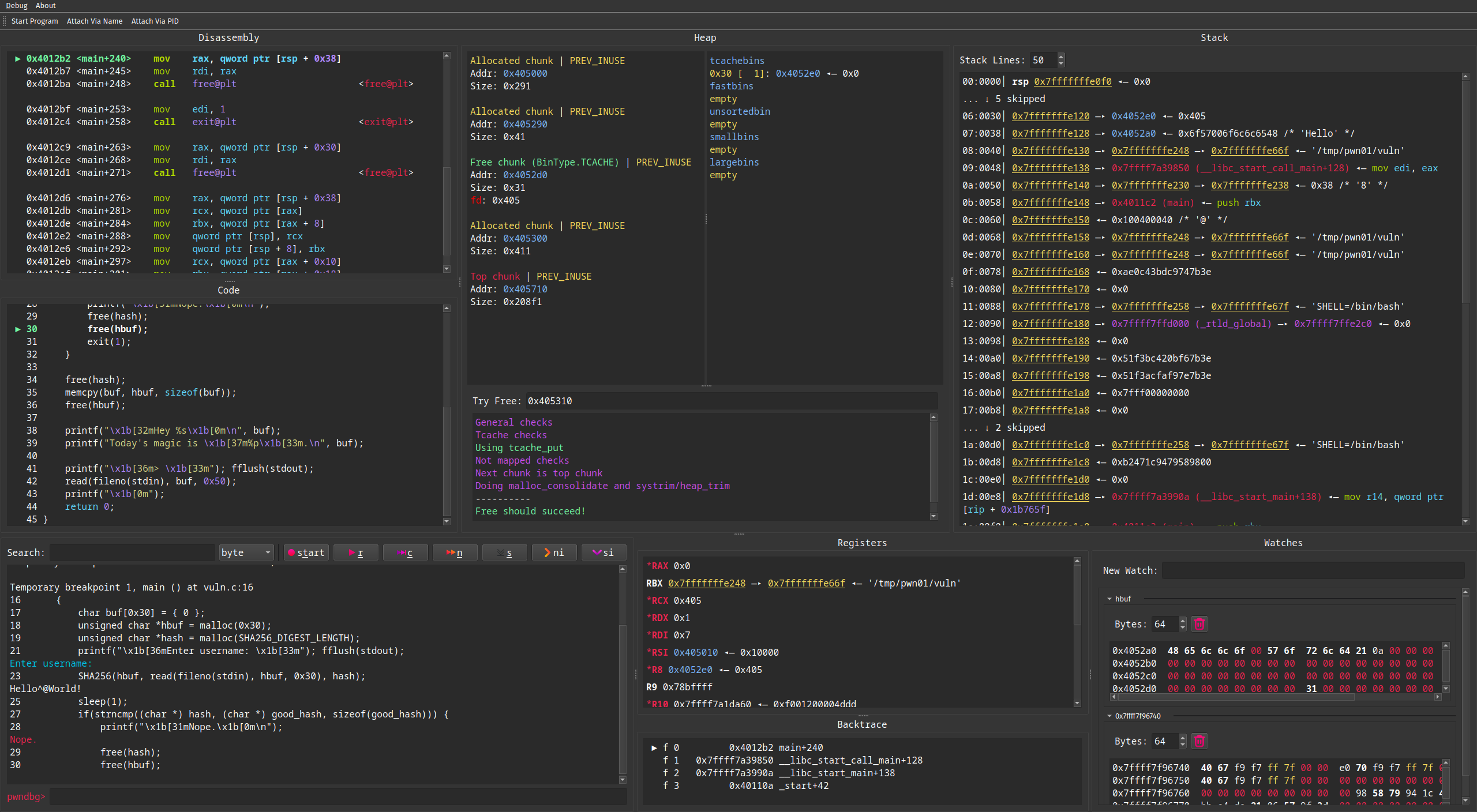An unofficial GUI wrapper around pwndbg intended to leverage the UI benefits of a graphical user interface.
- Install and setup pwndbg
- Optionally add any settings you want in
~/.gdbinit - Run
python start.py- This will create a virtual environment and install the needed dependencies
- On Debian/Ubuntu systems, you may need to previously install
python3-venv - If you want to attach to running programs, GDB needs to be started with sudo. To do this, copy
~/.gdbinitinto/rootand runpython start.py --sudoand enter your sudo password when prompted
- Resizable and collapsible panes
- Heap context
- Continuously show heap related information such as allocated chunks and freed bins
- Give easy access to
pwndbg'stry_freecommand
- Watch context
- Add multiple addresses to a watch context to continuously monitor the data in a hexdump format
- Context menus for Stack and Register contexts, that allow easy lookup via the
xinfocommand. - Keyboard shortcuts
- Shortcuts for GDB commands as well as GUI features
- Shortcuts are either displayed next to the action in a menu (e.g.
Ctrl + N) or shown by an underlined letter (pressingAlt + <LETTER>will activate the button / menu)
- Input byte literals
- When inputting to the inferior process (denoted by the label next to the main pane's input field) you can supply a python
bytesliteral - E.g.: Writing b"Hello\x00World\n" will interpret the input as a
bytesliteral and evaluate it accordingly
- When inputting to the inferior process (denoted by the label next to the main pane's input field) you can supply a python
- All existing GDB /
pwndbgcommands can still be executed via the Main input widget
pwndbg is a command line utility that greatly enhances gdb by allowing the user to more easily view data, as well as by adding many new commands.
As the dominant tools for debugging and pwning, they mostly suffer from the fact that they are bound to the limitations of terminal applications.
To address this we wanted to leverage a modern UI framework to wrap the most essential functionality.
This allows us to filter out, reorder and customize the gdb output, simplifying or highlighting important information.
Our GUI application primarily focuses on usability reducing the number of user commands, displaying information neatly, copying data easily, and providing hotkeys for control-flow.
The GUI is written using the Qt framework for python.
GDB is managed as a subprocess in MI mode and interaction is handled by pygdbmi.
To make the GUI more fluent and prevent hangups, the application is multithreaded.
The main thread is the GUI thread, which starts other threads that handle input to GDB (GdbHandler), collecting output from GDB (GdbReader) and interaction with the inferior process (InferiorHandler)
- If you are experiencing issues on startup relating to QT plugins not being found or loaded try to set
QT_DEBUG_PLUGINS=1for the user where the failure is occurring and retry. This will show you more debug output related to QT. Most likely you will have some missing dependencies that can be installed via your favourite package manager. On Ubuntu/Debian it was thelibxcb-cursor0library. See this SO post.
- Qt PySide6 as the GUI framework
- Pygdbmi for interaction with GDB in MI mode
- psutil for cross-platform access to process information
This tool was developed as project for the Binary Exploitation practical course at TUM. All features are targeted to complete the pwning challenges during the course. If you like it, but have a use case that is currently not supported feel free to open a PR or an issue.
